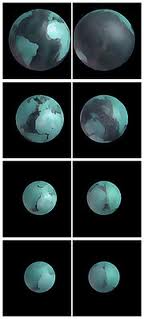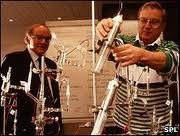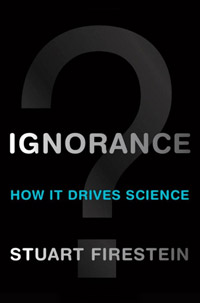by
Donald Prothero, Sep 19 2012

Most educated people in modern society have no difficulty accepting the idea that the earth is roughly spherical, or that the sun is the center of the solar system and the earth moves around it. Nearly everyone laughs, or shakes their head in disbelief whenever you tell them about people who seriously believe in a flat earth or groups of people who still don’t accept the discoveries of Galileo and Copernicus after 500 years. Yet both of these long-rejected ideas have strong adherents, mostly creationists who use literal interpretation of the Bible to deny any scientific reality that contradicts scripture. For these people to continue clinging to these long-discredited ideas, they must ignore the hundreds of photos from earth and space that show its true shape (the flat-earthers claim they are NASA hoaxes, although the other international space programs produce similar images). In addition, we now have space probes visiting all the planets on paths predicted by the heliocentric solar system, and some have looked back and taken shots that show the layout of the solar system, and the earth where it really is. But in this age of the internet, silly ideas like geocentrism can reach an audience of millions in seconds, without any fact checking or scientific peer review, which most mainstream media still practice. Any fool with a hot idea, a computer and possibly some decent graphics or animation can cook up a wild theory and instantly generate thousands of hits, and hundreds of favorable comments from those who can’t tell science from garbage. Continue reading…
comments (39)
by
Donald Prothero, Aug 29 2012

A Review of The Republican Brain: The Science of Why they Deny Science—and Reality by Chris Mooney, John Wiley, New York, 327 pages.
Reality has a well-known liberal bias.
—Stephen Colbert
Anti-intellectualism has been a constant thread winding its way through our political and cultural life, nurtured by the false notion that democracy means that ‘my ignorance is just as good as your knowledge’.
—Isaac Asimov
You can’t convince of believer of anything, for their belief is not based on evidence but on a deep-seated need to believe.
—Carl Sagan
Hearing the speakers at the GOP convention spout their ideas this week, I’m again reminded that an entire American political party is proudly and openly espousing views that are demonstrably contrary to reality, from claiming that rape does not cause pregnancy, to claiming that global climate change is a hoax, to even weirder idea, like the bizarre notion that the President of the United States is a Kenyan Muslim. For years, I’ve puzzled over why people can believe such weird things as creationism or other kinds of pseudoscience and science denials. In my 2007 book Evolution: What the Fossils Say and Why it Matters, I devoted an entire chapter to asking why creationists can so confidently believe patently false ideas, and refuse to look at any evidence placed in front of them. I’ve compared it to Alice’s Adventures Through the Looking Glass, where Alice steps through the mirror and finds that the objects and the landscape look vaguely familiar—but all the rules of logic are reversed or turned inside out. How can people continue to believe things that are clearly wrong, and refuse to change their ideas or look at evidence? Continue reading…
comments (125)
by
Donald Prothero, Aug 22 2012

Stanley Pons (right) and Martin Fleischmann with a publicity shot staged to show them “working” on their experiment in 1989
The first principle of science is that you must not fool yourself and you are the easiest person to fool.
—Richard Feynmann
The passing of Martin Fleischmann on August 3 brings to mind one of the most famous (and infamous) recent episodes in the history of science: the cold-fusion fiasco. Those of us who were involved in science in March 1989 (or just paying attention to the news) could not avoid hearing about Stanley Pons and Martin Fleischmann of the University of Utah supposedly producing nuclear fusion at room temperatures. Announced with great fanfare and huge press publicity on March 23, 1989, Pons and Fleischmann claimed that they had run simple electrochemical experiments in the lab that had managed to start a nuclear fusion reaction. Conventional nuclear physics had always argued that fusion (squeezing two or more atoms together to produce another atom) could only be produced at extreme temperatures and pressures, such as the fusion reactions that occur now to drive the heat engine at the core of the Sun. This is why nuclear fusion has only been used for hydrogen bombs and is not yet practical for nuclear energy or other peaceful uses. If Pons and Fleischmann were right, their discovery would revolutionize nuclear physics and possibly solve our energy problems with a source of energy that was cheap to obtain and not as dangerous as the various proposals for fusion reactors. The media immediately ran with the story on a massive scale, so that nobody who paid attention to the news at that time could possibly miss the message. Continue reading…
comments (41)
by
Brian Dunning, Aug 16 2012
 Most people get the right answer to the toothpaste puzzle, but it never ceases to surprise me how many get it wrong, and even staunchly argue their position. I’ve even seen it tested by taking a tube of toothpaste to the bottom of a swimming pool.
Most people get the right answer to the toothpaste puzzle, but it never ceases to surprise me how many get it wrong, and even staunchly argue their position. I’ve even seen it tested by taking a tube of toothpaste to the bottom of a swimming pool.
The question: What would happen if you took a tube of toothpaste to the bottom of the sea, and then opened it? It’s a great party question. Try it sometime. Continue reading…
comments (48)
by
Michael Shermer, May 22 2012
This review of Ignorance: How it Drives Science by Stuart Firestein (Oxford University Press, May 2012, ISBN 13: 97801-998-28074) was originally published in Nature, 484, 446–447 (26 April 2012) as “Philosophy: What we don’t know.”
At a press conference on February 12, 2002, the United State Secretary of Defense Donald Rumsfeld employed epistemology to the explain U.S. foreign entanglements and their unintended consequences: “There are known knowns. There are things we know we know. We also know there are known unknowns. That is to say, we know there are some things we do not know. But there are also unknown unknowns, the ones we don’t know we don’t know.”

It is this latter category especially that is the focus of Stuart Firestein’s sparkling and innovative look at ignorance, and how it propels the scientific process forward. Firestein is Professor and Chair of the Department of Biological Sciences at Columbia University, where he teaches a wildly popular course on ignorance, inviting scientists in as guest speakers to tell students not what they know but what they don’t know, and even what they don’t know that they don’t know. (Would you rather earn an A or an F in a class called “Ignorance”?, he muses.) This is a slim volume about a fat topic, but Firestein captures the essence of the problem by contrasting the public’s understanding of science as a step-wise systematic algorithm of grinding through experiments that churn out data sets to be analyzed statistically and published in peer-reviewed journals after a process of observation, hypothesis, manipulation, further observation, and new hypothesis testing, with the Princeton University mathematician Andrew Wiles’ description of science as “groping and probing and poking, and some bumbling and bungling, and then a switch is discovered, often by accident, and the light is lit, and everyone says, ‘Oh, wow, so that’s how it looks,’ and then it’s off into the next dark room, looking for the next mysterious black feline” (p. 2), in reference to the old proverb: “It is very difficult to find a black cat in a dark room. Especially when there is no cat.” Continue reading…
comments (22)
by
Brian Dunning, Apr 05 2012

An animation I made of the northern end of Santa Catalina Island. The lighter, lower contrast frames were later in the evening. CLICK TO WATCH THE ANIMATION.
One of the benefits of living on the coast is that I’m frequently treated to some amazing mirages out over the ocean. I took the accompanying photographs in February, which is when this phenomenon is most dramatic. It’s the coldest water of the year, with an average temperature of 57F. The average high air temperature is about 69F, and that warmer air is blown out to sea by onshore winds in the afternoon. It’s at this time, when the warmest air is out there around sunset, that the effect appears. Continue reading…
comments (3)
by
Donald Prothero, Apr 04 2012

The long-discredited idea of sauropods snorkeling in deep water as illustrated in this old painting by Zdenek Burian. The biggest problem is that they couldn't breathe in water this deep with the pressure it puts on their lungs.
The story popped into my email box earlier this week and soon I had dozens of follow-up emails from the vertebrate paleontology listserver flooding my inbox. Once again, the media have shown their complete inability to get the science right and publicized another flashy story that was complete garbage. I already gave an example last fall (my Nov. 2 post) with Mark McMenamin’s ridiculous claim that a giant Triassic “kraken” rearranged the bones of ichthyosaurs to create art. (By the way, that claim has dropped out of sight, and I don’t ever expect to see it published). As soon as the furor of that media gaffe dies out, however, they commit an even bigger blunder.
This time it was an article in the British media, starting with a “journalist” Tom Feilden (previously caught plagiarizing dino stories) reporting for the Telegraph doing an interview that then got coverage on both BBC radio and TV and on their website. In the brief story, a “Professor” Brian J. Ford makes the claim that giant sauropod dinosaurs were aquatic, not land-dwelling creatures. Immediately, the first reaction that my paleontologist colleagues and I had was “Who the hell is ‘Prof. Brian J. Ford’?” and “Did he say this in 1900?” To us, the article was startling not because it has some new insight on sauropods—but because someone who clearly had no idea about the last century of sauropod research had managed to get all this publicity, and there was no evidence he had any credentials to be taken seriously!
Continue reading…
comments (20)
by
Brian Dunning, Mar 08 2012
Pathological science is a term that refers to research characterized more by obsession than by results.
It’s something that most of us are probably subject to, to one degree or another. Many researchers, even hobbyists and enthusiasts, want for some one result in particular to be true. They’re always on the lookout for data that support their desired conclusion. This is not, by itself, pathological; but for some who take it to an extreme, it can become that way. Many famous cases of pathological science began as legitimate science, and often the researcher would become distracted by tiny results that suggested an effect when in fact there was none. Belief supplanted objectivity, and the science became pathological science. Continue reading…
comments (16)
by
Donald Prothero, Feb 29 2012

Fables should be taught as fables, myths as myths, and miracles as poetic fancies. To teach superstitions as truths is a most terrible thing. The child mind accepts and believes them, and only through great pain and perhaps tragedy can he be in after years relieved of them. In fact, men will fight for a superstition quite as quickly as for a living truth — often more so, since a superstition is so intangible you cannot get at it to refute it, but truth is a point of view, and so is changeable.
—Hypatia of Alexandria
I happened to be flipping through the cable TV movie channels the other night, and managed to catch the 2009 movie Agora, about the 4th century female astronomer and mathematician Hypatia of Alexandria. A Spanish production (in English) directed by Alejandro Amenabar, it received great reviews, seven Goya Awards in Spain, the Alfred P. Sloan Foundation Feature Film Prize at the Hamptons International Film Festival, and accolades at Cannes as well. It broke box office records in Spain. But it only played on four screens in the U.S. in very limited release in New York and LA, so almost no one in this country got to see it. Now, three years later, it appears on cable TV, and can be purchased on Amazon.com or rented on Netflix and other outlets. This seems to be a typical pattern of most thoughtful or provocative European movies that are not written for American teenage boys with lots of guns, violence, superheroes, and car crashes. If you don’t live in a major media center with lots of small independent theaters that cater to a worldly intelligent crowd that likes stimulating, challenging movies, you just have to wait for it to show up on cable or Netflix.
Although it has its flaws, it is a gem of a movie with amazing, provocative scenes and the overarching theme of religious intolerance suppressing science and free inquiry. It was filmed in Malta with minimal CG imagery, so it truly captures the milieu of the blazing Egyptian sun baking the ancient stone city of Alexandria. It portrays both the glories of the temples and monuments to a mixture of Egyptian, Greek, and Roman gods, and the degradation of the slums and the poor amidst great wealth. The acting by an international cast, including the luminous Rachel Weisz (as Hypatia), is excellent, and it does a far better job than most period pieces (especially the “sword and sandal” genre of films about ancient Rome) of capturing the essence of late Roman Alexandria. In that regard it evokes more recent efforts like Ridley Scott’s and Russell Crowe’s “Gladiator” and the HBO series “Rome”. Peter Bradshaw of The Guardian wrote that it is “an ambitious, cerebral and complex movie…Unlike most toga movies, it doesn’t rely on CGI spectacle, but real drama and ideas.” As many other reviewers noted, it is an historical epic (done on an epic scale) not about wars and conquests and romance, but about complex concepts and themes of science, religion, and intolerance.
Continue reading…
comments (51)
by
Donald Prothero, Feb 01 2012
It pops up in the news every few years, typically when eager politicians are looking for a cause to champion and raise voter anger, and make themselves popular as “guardians of our tax dollars.” The latest version is a recent article in The Los Angeles Times about “duh” science: research that appears to confirm what people regard as everyday knowledge. They included studies that demonstrated that alcohol reduces reaction time; that obese men have a lower chance of getting married; that people who live in safe well-lit neighborhoods are more likely to walk and get exercise; and that college drinking is just as bad as we all thought, but not worse than expected. Such stories are then grabbed out of context and flogged on talk shows as examples of government waste, and become the staple of politicians from both sides of the aisle, eager to enhance their standing with voters.
In this recent incarnation, Senator Tom Coburn (R.-OK) is castigating studies funded by the National Science Foundation which seem silly or frivolous to outsiders to bolster his cred as an anti-waste, anti-tax crusader. He has repeated called for the elimination of the NSF altogether, although he has no idea where American scientists would get their funding if he did so. In past years, the charge was led by Rep. John Dingell (D.-MI), who has served in the House since 1955, the longest serving member of the current Congress. A generation ago, it was Sen. William Proxmire (D-WI), who replaced Joe McCarthy in the Senate and served for 44 years. Proxmire created the famous “Golden Fleece” awards, which publicize what he regards as useless research. Or take a recent quote from that paragon of education and science, Sarah Palin, is in the same vein: “Some of these pet projects, they don’t really make a whole lot of sense and sometimes these dollars they go to projects having little or nothing to do with the public good, things like fruit fly research.”
Continue reading…
comments (114)




 Most people get the right answer to the toothpaste puzzle, but it never ceases to surprise me how many get it wrong, and even staunchly argue their position. I’ve even seen it tested by taking a tube of toothpaste to the bottom of a swimming pool.
Most people get the right answer to the toothpaste puzzle, but it never ceases to surprise me how many get it wrong, and even staunchly argue their position. I’ve even seen it tested by taking a tube of toothpaste to the bottom of a swimming pool.


